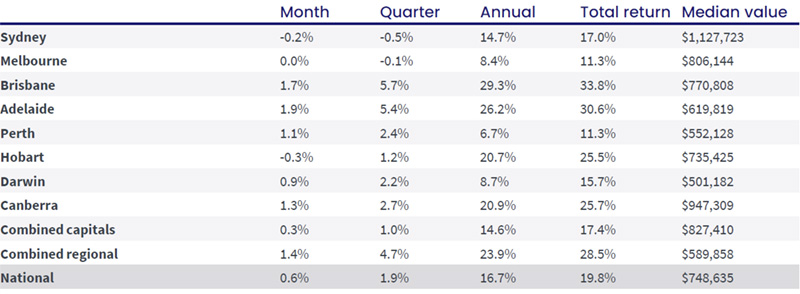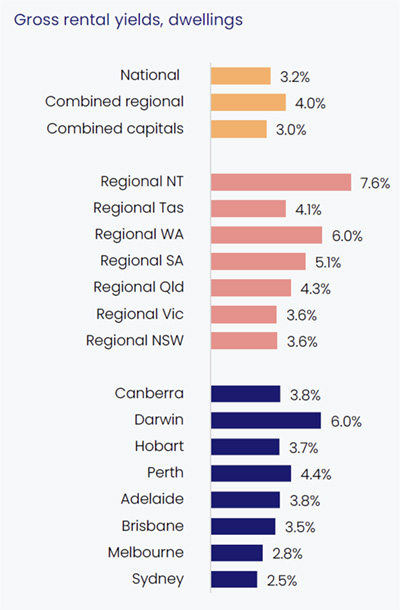Easing prices, rising rents luring investors and tempting new buyers
With property prices moderating and yields and vacancy rates hitting renters hard, the pendulum is swinging towards mortgages being cheaper than rents.
Sydney and Melbourne have recorded their first combined quarter of negative growth since the extended lockdowns of 2020.
With property prices moderating and rents and vacancy rates hitting renters hard, mortgages are becoming more affordable than rentals.
While property prices nationally were up just 0.6 per cent in April, and 1.9 per cent for the quarter, rents continued to rise sharply, up 2.7 per cent over the three months to April, taking the annual change in national rents to 9.0 per cent. A year ago, the annual change in national rents was 4.9 per cent, according to CoreLogic data released Monday (2 May).
A survey of 1,500 first-home buyers by Great Southern Bank found that more than two-thirds of first-home buyers (68 per cent) found themselves paying less or the same amount on a mortgage as they previously did on rent.
Regional first-home buyers are reaping the most significant benefits from buying, with almost three-quarters (74 per cent) of buyers reporting their housing costs decreased or stayed the same after getting onto the property ladder. That compares to 60 per cent of first-home buyers in living in and around Australian CBDs.
Mortgage repayments were often more affordable than budding first-home buyers expected – evidence suggests saving for a deposit remains the greatest challenge to home ownership. Only 38 per cent of first home buyers expected their housing costs to be less, but the reality for 42 per cent of homeowners was that their monthly repayments were less with a mortgage compared to renting.
Great Southern Bank’s Chief Customer Officer, Megan Keleher, said the trend was likely to continue.
“Many people have redirected discretionary spending throughout COVID-19 and lockdowns, building up savings that can go towards a deposit on a home.
“For those still trying to save, it is worth considering what support you may be eligible for under government schemes like the First Home Loan Deposit Scheme.
“Budding buyers may be pleasantly surprised to find that a mortgage might actually be more affordable than rent.”
Smaller capitals, regions thriving
Demonstrating the diversity in housing conditions across the broad regions of Australia, half of the capitals are still recording a monthly growth rate above 1 per cent. Adelaide, at 1.9 per cent growth in April, led the pace of capital gains, replacing by Brisbane at the top of the pile (1.7 per cent), followed by Canberra (1.3 per cent) and Perth (1.1 per cent).
Sydney and Melbourne were the main drag on the headline growth rates. Sydney housing values recorded the third consecutive month-on-month decline, down 0.2 per cent, while Melbourne values were down fractionally (-0.04 per cent). Technically values are down over three of the past five months in Melbourne. Hobart also recorded a negative monthly change (-0.3 per cent), the city’s first monthly fall in 22 months.
Change in dwelling values

CoreLogic Home Value Index Released 2 May 2022
CoreLogic’s Research Director Tim Lawless said the trend rate of growth is easing in most places.
Based on rolling quarterly change, Brisbane dwellings moved through a peak rate of growth in December last year at 8.5 per cent, slowing to 5.7 per cent over the most recent three-month period. Similarly, Adelaide moved through a peak in the trend rate of growth in January at 7.4 per cent, reducing to 5.4 per cent in April.
Perth and Darwin are the exceptions, where the rolling quarterly trend has gathered some steam since late last year. Perth housing values were up 2.4 per cent over the three months ending April compared with a recent lull through late last year when the quarterly trend fell to just 0.4 per cent.
“A rebound in migration rates as state and international borders re-opened could partially explain the renewed exuberance, along with persistently low advertised stock levels and strong economic conditions,” Mr Lawless says.
Regional housing markets have been somewhat insulated from the slowdown, with housing values up 1.4 per cent in April across the combined regionals index, compared with a 0.3 per cent gain across the combined capitals.
Advertised stock levels remain 42 per cent below the previous five-year average in the regions, while the volume of home sales is holding 20 per cent above the previous five-year average. The imbalance between available supply and demonstrated demand is a key factor supporting growth in housing prices across Regional Australia.
Investors eyeing yields
Higher rental yields and long-term prospects for capital growth could see investors comprising a larger portion of housing market activity.
Financial aggregates published by the RBA to the end of March showed the monthly gain in investor credit growth was at the highest level since August 2015, with the speed of investment credit growth surpassing owner occupier credit for the first time since December 2016.
Sam Inan, Principal Director Belle Property Brighton and St Kilda said Melbourne rentals are snapped up within days of being listed.

CoreLogic Home Value Index Released 2 May 2022
“It is really telling of the state of the market- as buyer demand slows, this uptick in the search for rentals highlights the changing Melbourne property landscape.
“This is the beginning of the market cooling off, so it could actually be a better time to look to buy.”
On an annual basis, house rents (up 9.1 per cent) are rising faster than unit rents (up 8.7 per cent), however this trend is changing sharply as demand for unit rentals increases, according to Mr Lawless.
“On a rolling quarterly basis, we are now seeing unit rents rising faster than house rents, especially in Sydney and Melbourne where rental conditions across the unit sector were previously much softer,” Mr Lawless said.
“The shift in rental demand towards units reflects both rental affordability pressures, which are deflecting more demand towards the ‘cheaper’ unit sector, and the return of overseas migrants and visitors.
“Rental demand from overseas arrivals tends to skew towards inner city and higher density precincts.”
In Sydney, unit rents were up 3.0 per cent over the three months ending April, a full percentage point higher than the rise in house rents (2.0 per cent). In Melbourne, the difference is starker, with unit rents 3.6 per cent higher over the past three months compared with a 1.2 per cent rise in house rents.
Brisbane and regional Queensland are also experiencing record low vacancy rates and soaring rents.




















